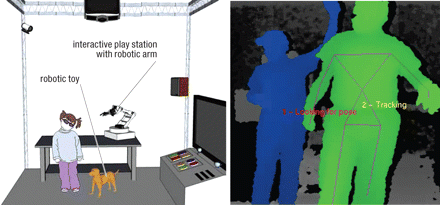Movement Abnormalities Studied as Clue to Mental Illness Risk
Abstract
University of Minnesota scientists have an audacious goal—to use some of the latest computer software technology to see whether there are differences in movement between children who are healthy and children who will later develop a psychiatric disorder.
The research team is headed by Nikolaos Papanikolopoulos, Ph.D., a professor of computer science and engineering at the university, and includes Kelvin Lim, M.D., a professor of psychiatry, and Kathryn Cullen, M.D., an assistant professor of psychiatry at the University of Minnesota Medical School.
The instrument that the scientists are using is a Microsoft product called a Kinect, which includes a camera and a computer. It shows the computer where a person is located in space and is able to track and analyze movements the person makes. Kinects are used in some computer games in which people can play golf, baseball, or other sports.

University of Minnesota scientists hope to use a Microsoft Kinect sensor (pictured in photo) to screen children for movement abnormalities that might indicate a psychiatric disorder. They are also planning to build an interactive play station with a robotic arm or robotic dog to screen children for such abnormalities (pictured in drawing).
The scientists are just starting to use Kinects to study the movements of apparently healthy preschoolers at the University of Minnesota lab school (with the permission of the parents) to establish norms. They will then compare movement patterns between healthy children and those with various psychiatric disorders.
Once a set of movement patterns that are associated with common childhood psychiatric disorders is established, the next step will be to conduct longitudinal investigations to confirm whether such abnormalities represent risk markers for later development of psychiatric illness. Finally, once risk markers are established, children might be screened for such markers at an early age. Children who are ultimately identified in this manner could be evaluated by a clinician, and a plan for monitoring and/or early intervention could then be set into motion.
"We think that early intervention will lead to better outcomes," Cullen told Psychiatric News. "So we are brainstorming ways by which we might advance such early intervention."
She and her colleagues got some of their ideas from Elaine Walker, Ph.D., a schizophrenia researcher at Emory University, Cullen said. "She looked at home videos made of children who later developed schizophrenia and noted some movements and facial expressions that differentiated them from normal-developing children."
Meanwhile, Papanikolopoulos is planning to build robots that could be used to screen children for abnormal movements, behaviors, body positions, and/or facial expressions. The robots would contain Kinects plus other software and specialized detectors. The robots might even be built in the shape of items that would appeal to children, such as a pet or a sandbox, and by interacting with children and eliciting certain movements, they would potentially allow for even more detailed monitoring and measurement of complex movements.
Papanikolopoulos and his colleagues expect to have their first robot built within a year, he told Psychiatric News.
"This is a fascinating concept," David Fassler, M.D., a clinical professor of psychiatry at the University of Vermont and a child and adolescent psychiatrist, commented. "It's certainly plausible that children with subtle, but identifiable movement abnormalities could be at increased risk for the development of specific psychiatric disorders. The team deserves credit for thinking out of the box. I look forward to following their research."
Papanikolopoulos is credited with being the major driving force behind the Scout, a small reconnaissance robot now used by the U.S. Army. He and his team have also built a robotic scrub nurse and a robotic system that monitors a patient's movements during radiation therapy. He is also interested in using computer vision techniques for monitoring driver fatigue, monitoring safety in work zones, and tracking pedestrians and vehicles.
The scientists' research is being funded by two grants from the National Science Foundation (NSF) of more than $3 million. "I recently learned that NSF has awarded two even larger grants of $10 million to two other groups for similar projects," Cullen said.
More information about the research is posted at <www1.umn.edu/news/news-releases/2011/UR_CONTENT_304914.html> and at <www.cs.umn.edu/people/faculty/npapas>.



